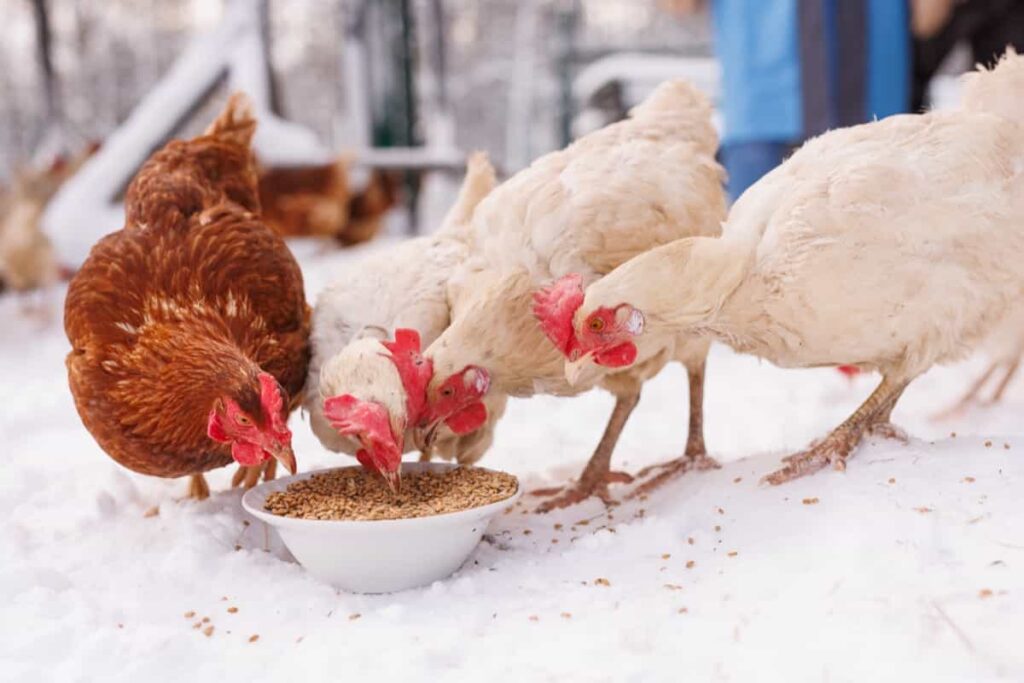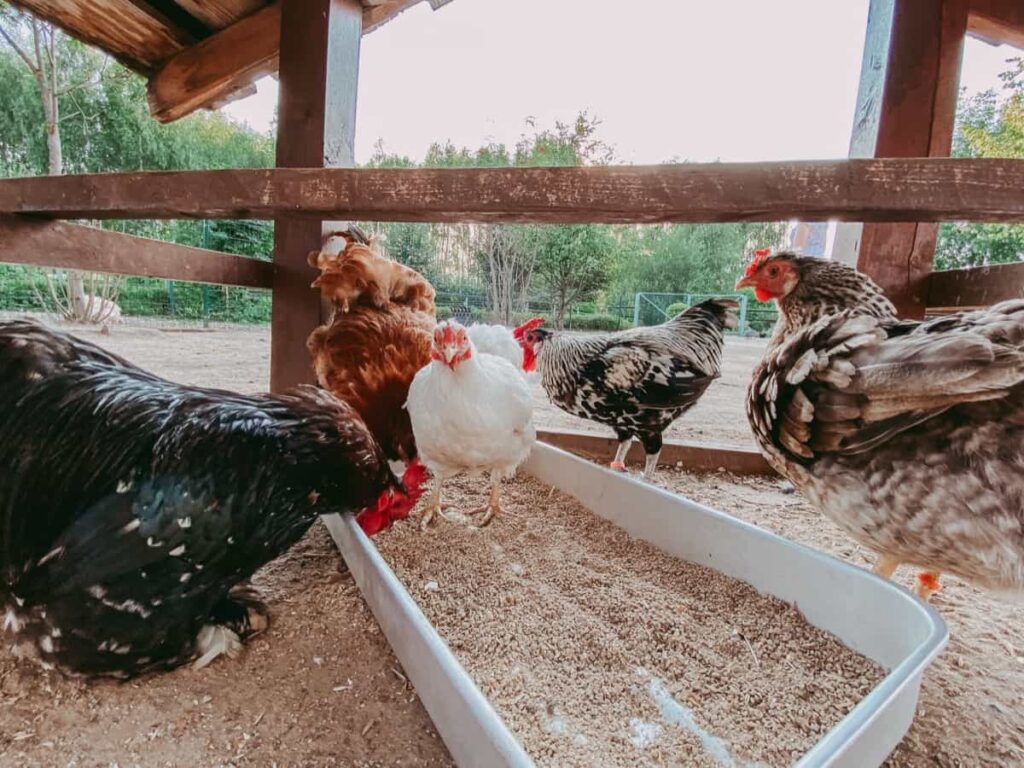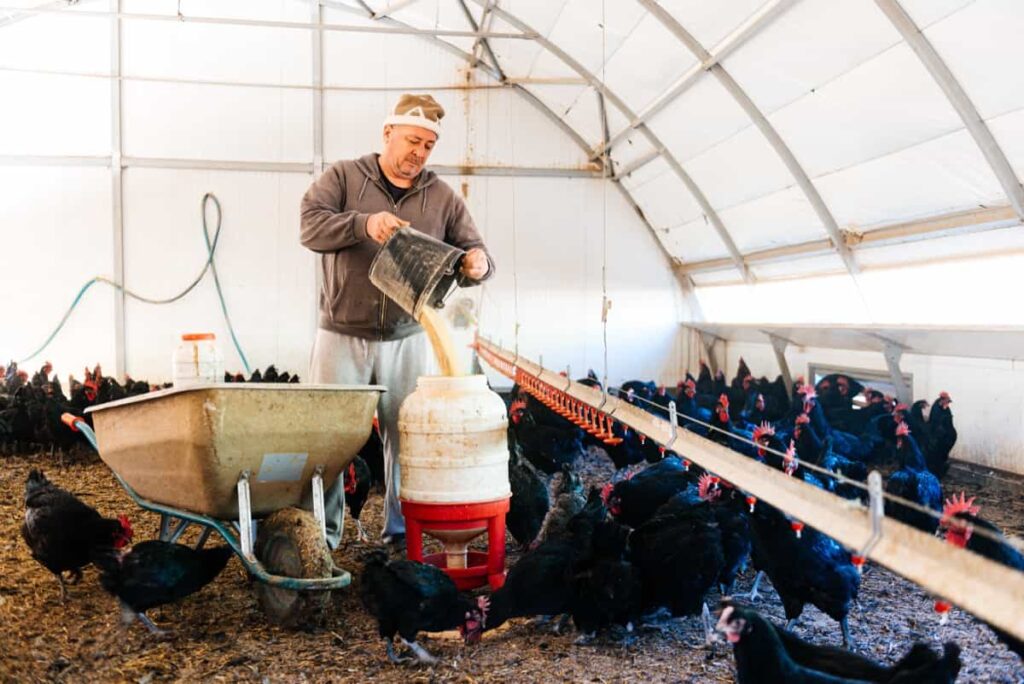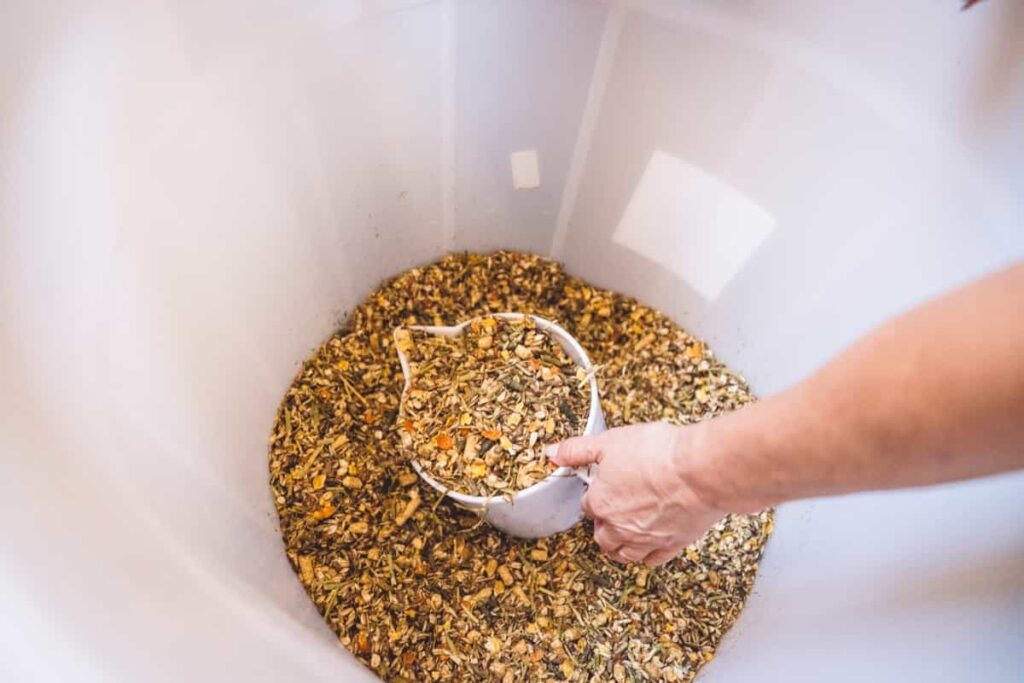Fermenting Chicken FeedMastering the flock is all about understanding your chickens’ needs and providing them with the best care possible. By creating a strong bond with your feathered friends, you can ensure a happy and healthy flock. Fermenting chicken feed is a process of soaking and fermenting grains in water to create a probiotic-rich food source for your flock.

Overview of Fermented Chicken Feed
Definition
Fermented chicken feed is a process where the feed is soaked in water and allowed to ferment. This results in a probiotic-rich mixture that can work wonders for your flock’s health. By fermenting their feed, you’re providing your chickens with a natural source of beneficial bacteria that aids digestion and boosts their overall immunity.
Benefits of Fermentation
Fermenting chicken feed offers a wide range of benefits that can improve the flock’s health and productivity. The key advantage is the enhanced digestibility of fermented feed, which allows chickens to absorb nutrients better and support their overall well-being. Another benefit of fermenting chicken feed is its positive impact on egg quality and production rates. Chickens fed with fermented feed often lay eggs with stronger shells and richer yolks, leading to higher-quality products for you to enjoy.
The Science Behind Fermentation
How Fermentation Works
Fermentation is a fascinating natural process that transforms feed into a powerhouse of nutrients for your chickens. It involves the breakdown of carbohydrates by beneficial bacteria, which release enzymes and organic acids. The pH level decreases, creating an acidic environment that inhibits harmful pathogens while promoting the growth of beneficial microbes. This results in improved gut health for your flock.
Nutritional Enhancements Through Fermentation
Fermentation increases the bioavailability of essential nutrients like minerals, amino acids, and vitamins in the feed. By unlocking these nutrients through fermentation, you are providing your chickens with a more balanced and easily digestible diet to support their overall health and productivity.
Getting Started with Fermenting Chicken Feed
Essential Supplies and Ingredients
The essential supplies for fermenting chicken feed you’ll need include a container, water, feed, and a stir stick. Opt for a non-metallic container like a bucket or large jar to avoid any chemical reactions between metal and the fermented feed. When it comes to ingredients, choose high-quality grains like corn, barley, or oats for fermentation. These grains are rich in nutrients that will benefit your chickens’ overall health and egg production.
In case you missed it: Guide to Black Star Chicken: Characteristics, Egg Production, Raising, Diet, Care, Price, and Lifespan

Choosing the Right Type of Feed for Fermentation
Choosing the right type of feed for fermentation is crucial to ensure that your chickens receive all the necessary nutrients they need. By selecting high-quality grains, seeds, and other ingredients, you can optimize their health and well-being. Experiment with different combinations to see what works best for your flock. Fermenting chicken feed is a simple yet effective way to boost the overall health of your poultry while also saving money on feed costs.
The Fermentation Process: Step-by-Step Guide
Preparation and Initial Steps
To start, gather your supplies: a container with a lid, water de-chlorinator, feed of your choice, and some warm water. Begin by pouring the desired amount of feed into your container and then covering it with enough warm water to submerge the feed fully. Add a small amount of dechlorinated water to neutralize any chlorine that could hinder fermentation.
Give the mixture a good stir to ensure all the feed is moistened evenly before securing the lid on top. Make sure to check on your fermenting feed regularly and give it a gentle stir once or twice daily to prevent mold growth. Then, you’ll have nutrient-rich fermented feed ready to nourish your flock.
Monitoring the Fermentation Process
Once you’ve started fermenting your chicken feed, monitoring the process is key to ensuring its success. Keep a close eye on the texture and smell of the fermented feed as it progresses. You want it to have a slightly sour aroma, indicating that the fermentation is happening as it should. Make adjustments as needed along the way to ensure optimal conditions for chicken feed fermentation.
Tips for Successful Feed Fermentation
Maintaining the Right Temperature and Environment
Maintaining the right temperature and environment is key to successful feed fermentation. Ensure that the temperature is consistent, ideally around 21-29°C, for optimal results. Avoid extreme cold or heat, as it can disrupt the fermentation process.
Troubleshooting Common Issues
Choose a well-ventilated area for fermenting your chicken feed to prevent mold growth. Keep the containers covered with breathable cloth to allow air circulation while keeping out pests. If you encounter issues like foul smell or slimy texture during fermentation, it could indicate bacterial contamination. In such cases, discard the batch immediately and start fresh with clean equipment and ingredients. Use clean utensils to avoid introducing harmful bacteria into the mix.
Feeding Your Chickens Fermented Feed
How to Introduce Fermented Feed to Chickens
Start by mixing a small amount of fermented feed with their regular feed and observe how they react. Slowly increase the ratio of fermented feed over time. It’s essential to monitor your flock during this transition period. Watch for signs of digestive upset or reluctance to eat the new feed. Patience is crucial, as chickens can be creatures of habit.
Determining the Right Amounts and Frequency
Determining the right amounts and frequency of feeding fermented feed will depend on factors like breed, age, and overall health of your chickens. It may take some trial and error to find the perfect balance that works best for your flock. Remember, every chicken is unique, so what works for one might not work for another. Please pay attention to their behavior and adjust accordingly.
Safety Considerations and Best Practices
Identifying and Preventing Contamination
Contamination can occur if proper precautions are not taken. To identify and prevent contamination, always use clean equipment and containers for the fermentation process. Regularly inspect the feed for signs of mold or off smells. By following safety considerations, you can ensure that your chickens receive high-quality, uncontaminated fermented feed that promotes their health and well-being.
In case you missed it: Kadaknath Chicken Farming in India: Exploring Profitable Black Chicken Farming Business Plan

Storage and Handling of Fermented Feed
Proper storage of fermented feed is essential to maintain its quality and prevent spoilage. Store the fermented feed in a cool, dry place away from direct sunlight and moisture. Use airtight containers to keep out pests and contaminants. Handling fermented feed safely involves washing hands before and after handling the feed. Avoid cross-contamination by using separate utensils for feeding fermented feed to chickens.
The Impact of Fermented Feed on Chicken Health and Productivity
Improvements in Digestive Health
Fermented feed can have a significant impact on the health and productivity of your chickens. By improving their digestive health, fermented feed can help ensure that your flock can absorb nutrients more effectively. This can lead to healthier chickens overall.
Effects on Egg Quality and Production Rates
The effects of fermented feed on egg quality are notable. Chickens that consume fermented feed may produce eggs with stronger shells and richer yolks. This can be beneficial if you’re looking to sell or consume high-quality eggs. In terms of production rates, providing fermented feed to your chickens may increase egg production. The improved digestibility of the food could potentially translate into more consistent laying patterns from your flock.
Economic Benefits and Cost Savings
Reducing Feed Waste and Lowering Feed Costs
Fermenting chicken feed creates a pre-digested form that is easier for chickens to digest, meaning they can absorb nutrients from the same amount of food. By fermenting the feed, you are essentially maximizing its nutritional value and ensuring that your chickens are getting the most out of every bite. Reducing feed waste also plays a role in cost savings. When you ferment chicken feed, there is less likelihood of spillage or selective eating by the birds.
ROI: Evaluating the Financial Benefits
Evaluating the Return on Investment (ROI) of this practice is crucial for understanding its impact on your bottom line. By reducing feed waste and lowering overall feed costs, fermenting chicken feed can lead to significant savings over time.
The initial investment in fermenting equipment for chicken feed and supplies can pay off quickly as you see a decrease in the amount of feed being consumed by your chickens. Consider keeping detailed records of your expenses and savings related to fermenting chicken feed so you can accurately evaluate the ROI for your specific situation.
In case you missed it: How to Raise Delaware Chickens: A Comprehensive Guide for Beginners

Conclusion
Fermenting chicken feed is a cost-effective way to enhance your flock’s diet naturally. The fermented feed provides beneficial bacteria that support their immune system and improve digestion. Plus, it can lead to increased egg production and better-quality eggs. Understanding the importance of fermenting chicken feed can significantly benefit your flock’s health.
- Management Pests and Diseases in Your Cotton Field
- Sheep Farming Business Plan for Beginners
- Aquaponic Farming at Home: A Step-By-Step Guide
- Profitable Village Farming Business Ideas in 2024
- High-Yield Aquaculture: Fast-Growing Fish for Farming
- Effective Fish Pond Construction Techniques for Beginners
- Irrigation and Water Management in Pineapple Farming
- Blossom to Harvest: Mastering Flowering and Pollination in Papaya Farming
- Pig Fattening Essentials: From Selection to Sale for Beginners
